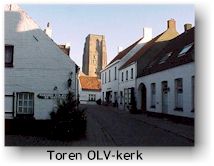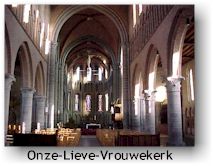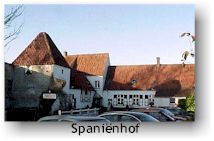
» Aardenburg
» Abbey of Ter Doest
» Adegem
» Bruges
» Castle of Middelburg
» Donk
» Dudzele
» Fort of Bavaria
» Knokke-Heist
» Koolkerke
» Lissewege
» Maldegem
» Male
» Middelburg
» Oedelem
» Sint-Anna-Ter-Muiden
» Sluis

 |
Lissewege
 Between
Bruges and Zeebruges, not far away from
Dudzele, lies the peaceful village of Lissewege. Nowadays
it is largely known as an artist's village. Lissewege is also
called the white village, after the white chalked houses. At
present, agriculture is the most important form of industry.
But it was especially textile that made it one of the richest
and most densily populated places in Flanders, although another
source tells us that the village merely counted some 500
inhabitants in the Middle Ages. Between
Bruges and Zeebruges, not far away from
Dudzele, lies the peaceful village of Lissewege. Nowadays
it is largely known as an artist's village. Lissewege is also
called the white village, after the white chalked houses. At
present, agriculture is the most important form of industry.
But it was especially textile that made it one of the richest
and most densily populated places in Flanders, although another
source tells us that the village merely counted some 500
inhabitants in the Middle Ages.
 The
name of this place was recorded for the first time in 961 and
the village thanks its existence to the construction of dikes
that served as a protection of the region against the sea. Some
2 centuries later, the cultivation of the grounds was started by
the abbey of Ter Doest, a
division of the abbey of Ter Duinen (Koksijde). Because of the
importance of this abbey for the area, she is more extensively
described on another page (click
here). The
name of this place was recorded for the first time in 961 and
the village thanks its existence to the construction of dikes
that served as a protection of the region against the sea. Some
2 centuries later, the cultivation of the grounds was started by
the abbey of Ter Doest, a
division of the abbey of Ter Duinen (Koksijde). Because of the
importance of this abbey for the area, she is more extensively
described on another page (click
here).
 Whether
the village counted a lot of inhabitants or not, 500 or more,
fact is that the church is gigantic and this certainly in
relation to the village itself. The big church, with a tower of
50 meters (and actually only for 2/3 finished), was built
between 1230 and 1270. How is it possible that such a small
village could build such a large church? There are several
stories that try to explain it. Most likely to be true is that
she was constructed under supervision of the Templer Knights.
These knights had to protect the pilgrims that were on their way
to Santiago de Compostela, Rome and Jerusalem. For pilgrims
coming from the north, their long journey began in Lissewege.
Probably the church was financed by sacrificial gifts from the
many pilgrims that passed this place. Not far from the church,
in the 13th century, a castle (called the Upperhof) was built.
Unfortunately, it doesn't exist anymore. Whether
the village counted a lot of inhabitants or not, 500 or more,
fact is that the church is gigantic and this certainly in
relation to the village itself. The big church, with a tower of
50 meters (and actually only for 2/3 finished), was built
between 1230 and 1270. How is it possible that such a small
village could build such a large church? There are several
stories that try to explain it. Most likely to be true is that
she was constructed under supervision of the Templer Knights.
These knights had to protect the pilgrims that were on their way
to Santiago de Compostela, Rome and Jerusalem. For pilgrims
coming from the north, their long journey began in Lissewege.
Probably the church was financed by sacrificial gifts from the
many pilgrims that passed this place. Not far from the church,
in the 13th century, a castle (called the Upperhof) was built.
Unfortunately, it doesn't exist anymore.
 The
religious wars caused the decline of the textile industry and
meant the end of the prosperity of the village. In 1571, the
abbey of Ter Doest was destructed by the Geuzen (protestant
religious fighters) and in 1586, the church was plundered.
However, a part of the church's treasures could be saved.
Nowadays it is a very pleasant and quiet place with several nice
little restaurants. The
religious wars caused the decline of the textile industry and
meant the end of the prosperity of the village. In 1571, the
abbey of Ter Doest was destructed by the Geuzen (protestant
religious fighters) and in 1586, the church was plundered.
However, a part of the church's treasures could be saved.
Nowadays it is a very pleasant and quiet place with several nice
little restaurants.
From Damme it's
about a 10-minutes-drive to Lissewege. From the market square
in Damme, cross the Damse
Vaart and follow the signs "Dudzele".
Once you pass the center of Dudzele, you cross the
Boudewijnkanaal and turn right immediately after the bridge over
the canal. Via this road you will end up automatically in
Lissewege. Next to this road lies also the domain of the abbey
of Ter Doest.
Worth seeing:
Onze-Lieve-Vrouwechurch, Abbeyfarm
Ter Doest, Abbeybarn of Ter Doest, old presbytery, view of
the village.
You can find more information on Lissewege on:
www.xplorengo.com or
www.lissewege.be
|











»
www.xplorengo.com
»
www.lissewege.be
|


 Between
Between
 The
name of this place was recorded for the first time in 961 and
the village thanks its existence to the construction of dikes
that served as a protection of the region against the sea. Some
2 centuries later, the cultivation of the grounds was started by
the abbey of
The
name of this place was recorded for the first time in 961 and
the village thanks its existence to the construction of dikes
that served as a protection of the region against the sea. Some
2 centuries later, the cultivation of the grounds was started by
the abbey of  Whether
the village counted a lot of inhabitants or not, 500 or more,
fact is that the church is gigantic and this certainly in
relation to the village itself. The big church, with a tower of
50 meters (and actually only for 2/3 finished), was built
between 1230 and 1270. How is it possible that such a small
village could build such a large church? There are several
stories that try to explain it. Most likely to be true is that
she was constructed under supervision of the Templer Knights.
These knights had to protect the pilgrims that were on their way
to Santiago de Compostela, Rome and Jerusalem. For pilgrims
coming from the north, their long journey began in Lissewege.
Probably the church was financed by sacrificial gifts from the
many pilgrims that passed this place. Not far from the church,
in the 13th century, a castle (called the Upperhof) was built.
Unfortunately, it doesn't exist anymore.
Whether
the village counted a lot of inhabitants or not, 500 or more,
fact is that the church is gigantic and this certainly in
relation to the village itself. The big church, with a tower of
50 meters (and actually only for 2/3 finished), was built
between 1230 and 1270. How is it possible that such a small
village could build such a large church? There are several
stories that try to explain it. Most likely to be true is that
she was constructed under supervision of the Templer Knights.
These knights had to protect the pilgrims that were on their way
to Santiago de Compostela, Rome and Jerusalem. For pilgrims
coming from the north, their long journey began in Lissewege.
Probably the church was financed by sacrificial gifts from the
many pilgrims that passed this place. Not far from the church,
in the 13th century, a castle (called the Upperhof) was built.
Unfortunately, it doesn't exist anymore.  The
religious wars caused the decline of the textile industry and
meant the end of the prosperity of the village. In 1571, the
abbey of Ter Doest was destructed by the Geuzen (protestant
religious fighters) and in 1586, the church was plundered.
However, a part of the church's treasures could be saved.
Nowadays it is a very pleasant and quiet place with several nice
little restaurants.
The
religious wars caused the decline of the textile industry and
meant the end of the prosperity of the village. In 1571, the
abbey of Ter Doest was destructed by the Geuzen (protestant
religious fighters) and in 1586, the church was plundered.
However, a part of the church's treasures could be saved.
Nowadays it is a very pleasant and quiet place with several nice
little restaurants.